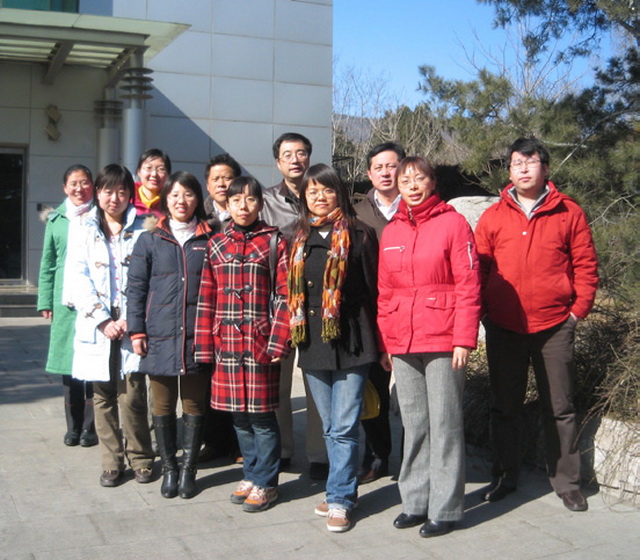Hou LY, Li Y, Shi HQ, Tian DS, Wang BX, Li LH*, Zhang LH*. 2018. Moderate grazing has little effect on global warming potential in the temperate steppes of northern China. Atmospheric Environment, 190: 342-348.
Liu W, Lu XT, Xu WF, Shi HQ, Hou LY, Li LH*, Yuan WP*. 2018. Effects of water and nitrogen addition on ecosystem respiration across three types of steppe: The role of plant and microbial biomass. Sci. Total Environ., 619: 103-111.
Zhang LH*, Hou LY, Guo DF, Li LH, Xu XF*. 2017.Interactive impacts of nitrogen input and water amendment on growing season fluxes of CO2, CH4, and N2O in a semiarid grassland, Northern China. Sci. Total Environ., 578: 523-534.
Bai WM, Zhou M, Fang Y, Zhang WH*. 2017. Differences in spatial and temporal root lifespan of three Stipa grasslands in northern China. Biogeochemistry, 132: 293-306.
Shi HQ, Hou LY, Yang LY, Wu DX, Zhang LH, Li LH*. 2017. Effects of grazing on CO2, CH4, and N2O fluxes in three temperate steppe ecosystems. Ecosphere, 8: e01760
Qu Luping, Chen Jiquan, Dong Gang, Jiang Shicheng, Li Linghao, Guo Jixun, Shao Changliang*. 2016.Heat waves reduce ecosystem carbon sink strength in a Eurasian meadow steppe. Environmental Research, 144: 39-48.
Han Juanjuan, Li Linghao, Chu Housen, Miao Yuan, Chen Shiping, Chen Jiquan*.2016. The effects of grazing and watering on ecosystem CO2 fluxes vary by community phenology. Environmental Research, 144: 64-71.
Bai Wenming, Guo Dali, Tian Qiuying, Liu Nana, Cheng Weixin, Li Linghao, Zhang Wenhao*. 2015.Differential responses of grasses and forbs led to marked reduction in below-ground productivity in temperate steppe following chronic N deposition. Journal of Ecology, 103: 1570-1579.
Bai Wenming, Fang Ying, Zhou Meng, Xie Ting, Li Linghao, Zhang Wenhao*. 2015. Heavily intensified grazing reduces root production in an Inner Mongolia temperate steppe. Agriculture, Ecosystems and Environment, 200: 143- 150.
Qu Luping, Chen Jiquan, Dong Gang, Jiang Shicheng, Li Linghao, Guo Jixun*, Shao Changliang*. 2015. Heat waves reduce ecosystem carbon sink strength in a Eurasian meadow steppe. Environmental Research, DOI: 10.1016/ j.envres.2015.09.004.
Zhang Lihua, Huo Yawen, Guo Dufa, Wang Qibing*, Bao Yin, Li Linghao*. 2014. Effects of multi-nutrient additions on GHG fluxes in a temperate grassland of northern China. Ecosystems, 17: 657-672.
Han Juanjuan, Chen Jiquan, Han Guodong, Shao Changliang, Sun Hailian, Li Linghao*. 2014. Legacy effects from historical grazing enhanced carbon sequestration in a desert steppe. Journal of Arid Environment, 107: 1-9.
Zhang LH, Song CL, Nkrumah PN. 2013. Responses of ecosystem carbon dioxide exchange to nitrogen addition in a freshwater marshland in Sanjiang Plain, Northeast China. Environmental Pollution, 80: 55-62.
Lu P, Wang L, Niu Z, Li LH, Zhang WH. 2013. Prediction of soil properties using laboratory VIS–NIR spectroscopy and Hyperion imagery. Journal of Geochemical Exploration, 132: 26–33.
Shao CL, Chen JQ, Li LH. 2013. Grazing alters the biophysical regulation of carbon fluxes in a desert steppe. Environmental Research Letters, 8(3): 35033.
Yang H-J, Jiang L, Li L-H, Li A, Wu M-Y, Wan S-Q. 2012. Diversity-dependent stability under mowing and nutrient addition: evidence from a 7-year grassland experiment. Ecology Letters, 15: 619–626.
Fang Y, Xun F, Bai W-M, Zhang W-H, Li L–H. 2012. Long-term nitrogen addition leads to loss of species richness due to litter accumulation and soil acidification in a temperate steppe. PLoS ONE, 7: e47369.
Bai W-M, Xia J-Y, Wan S-Q, Zhang W-H, Li L-H.2012. Day and night warming have different effect on root lifespan. Biogeosciences, 9: 375-384. 



